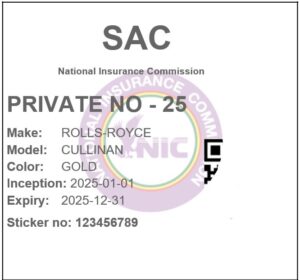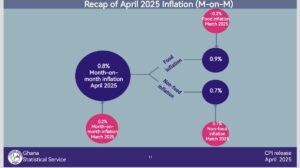
By Bernard AKYIN-ARKOH
In recent years, technological innovation has transformed many sectors, and the insurance industry is no exception.
A notable development in Ghana’s motor insurance sector is the introduction of the Motor Insurance Database (MID), a digital platform designed to simplify and enhance the verification of motor insurance coverage.
With this technological advancement, the role and necessity of the traditional motor insurance sticker displayed on vehicle windscreens have come under renewed scrutiny.
Compulsory motor insurance in Ghana
In some countries, such as Ghana, it is a legal requirement to have motor insurance. The Motor Vehicles (Third Party Insurance) Act, 1958 enforces the compulsory nature of motor third-party insurance in Ghana as articulated in Section 3(1) of the Act, which reads; ‘’Subject to the provisions of this Act no person shall use, or cause or permit any other person to use, a motor vehicle unless there is in force in relation to the user of that motor vehicle by such person or such other person, as the case may be, such a policy of insurance or such security in respect of third party risks as complies with the provisions of this Act.’’

The Motor Insurance Database in Ghana
The Motor Insurance Database (MID) marks a significant step forward in modernizing Ghana’s insurance industry. The MID, which took effect on 1st January 2020, was introduced with the aim of eliminating the problem of vehicles operating with fake motor insurance stickers, thereby protecting lives and property.
This centralized digital system captures real-time data on insured vehicles, allowing authorities and stakeholders to swiftly confirm a vehicle’s insurance status without relying on physical documents.
By simply dialing *920*57# and following the prompts to enter a vehicle’s registration number, users can instantly retrieve insurance details such as the vehicle make, vehicle color, name of the insurer, policy start date and policy expiration date.
One of the key benefits of the MID is its ability to improve the efficiency and accuracy of insurance verification. With up-to-date data at their fingertips, enforcement officers can minimize fraudulent practices and ensure that all vehicles on the road are adequately insured. This move toward electronic verification reflects global trends in insurance technology.
Nevertheless, the human factor remains an important consideration. In areas with limited digital infrastructure or connectivity, individuals may lack immediate access to electronic verification systems. In such cases, a visible insurance sticker on the vehicle’s windscreen can still serve as a practical proof of insurance coverage.
Despite the clear advantages of the MID, challenges remain. Technical issues or system downtimes may hinder instant electronic verification in some situations. Additionally, certain stakeholders may still prefer or require a tangible, physical representation of insurance coverage, which sustains the relevance of motor insurance stickers in specific contexts.
The shift away from physical motor insurance stickers
With the rollout of the Motor Insurance Database, the longstanding practice of displaying motor insurance stickers on vehicle windscreens has gradually declined. Digital verification now provides instant confirmation of insurance status, reducing the reliance on physical stickers as proof of insurance.
This shift raises an important question: Is it legally mandatory to display a motor insurance sticker on your windscreen?
Interestingly, the requirement to display a motor insurance sticker is not expressly stated in the Insurance Act, 2021 (Act 1061). Instead, it is based on a combination of legal provisions and regulatory directives under Ghana’s insurance and traffic laws.
Under the Motor Vehicles (Third Party Insurance) Act, 1958 (No. 42), Section 3(1) stipulates: “Subject to the provisions of this Act no person shall use, or cause or permit any other person to use, a motor vehicle unless there is in force in relation to the user of that motor vehicle by such person or such other person, as the case may be, such a policy of insurance or such security in respect of third party risks as complies with the provisions of this Act.” This establishes the legal obligation to have valid motor insurance in place.
For proof of insurance, Section 17(1) of the same Act states: “Any person driving a motor vehicle on a highway shall, on being so required by a police officer, give his name and address and the name and address of the owner of the motor vehicle and shall produce his certificate of insurance and any person contravening the provisions of this subsection shall be guilty of an offence against this Act.” This indicates that drivers must keep the insurance certificate available for inspection upon request.
While the Insurance Act, 2021 (Act 1061) does not explicitly require the placement of insurance stickers on vehicle windscreens, it grants the National Insurance Commission (NIC) the authority to regulate and oversee the insurance industry. Under Section 203, the NIC is empowered to establish necessary forms, certificates, and documents for compliance.
As a result, the practice of displaying the insurance sticker on the windscreen stems from regulatory directives issued by the NIC, enforced in practice by the Motor Traffic and Transport Department (MTTD) of the Ghana Police Service.
With respect to the roadworthy certificate, the Road Traffic Act, 2004 (Act 683) explicitly requires that a roadworthy sticker be displayed. According to Section 95 of the Act:
Section 95 – Issue of Road Use Certificate/sticker
- The Licensing Authority shall upon payment of the prescribed fee, issue to the applicant a certificate in the form of a sticker for the motor vehicle.
- The sticker shall be carried on the front windscreen of the motor vehicle so as to be readily identified by a police officer or the Licensing Authority.
- The road use certificate shall remain valid for six months in the case of commercial vehicles and twelve months in the case of private motor vehicles from the date of issue and shall then expire.
- Where the Licensing Authority is satisfied that a road use certificate has become defaced or is lost, the Licensing Authority may issue a duplicate road use certificate upon payment of the prescribed fee.
This provision clearly establishes the legal requirement to display the roadworthy sticker on the windscreen, in contrast to the more implied or directive-based requirement for insurance stickers.
Conclusion
In Ghana’s evolving insurance environment, shaped by the Motor Insurance Database, the necessity of displaying a motor insurance sticker on vehicle windscreens requires nuanced consideration.
While digital verification offers enhanced efficiency and reliability, the continued use of physical stickers addresses practical challenges such as system downtimes and accessibility gaps, especially in less connected regions.
Achieving a balanced integration of technological progress with traditional practices will be essential for ensuring effective and inclusive insurance verification in Ghana’s motor insurance landscape.
>>>the writer is a Chartered Insurance Practitioner (ACII-UK), Chartered Property Casualty Underwriter (CPCU) and an Associate in Risk Management (ARM). He is an accomplished author. Bernard was honored as the 2nd runner-up for the 2024 AIO-YIPs African Next Generation Award and received the Young Achiever Award at the 2024 Ghana Insurance Awards. He holds an Executive MBA in Finance from the University of Ghana, Legon, and is currently serving as a manager at Star Assurance Limited. In addition to his professional roles, Bernard is a resource person for the Ghana Insurance College (GIC) and a member of the Professional Education and Research Committee of the Chartered Insurance Institute of Ghana (CIIG). He can be reached via 233249236939 and or [email protected]
References
- Insurance Act, 2021 (Act 1061)
- The Motor Vehicles (Third Party Insurance) Act, 1958 (No. 42)
- Road Traffic Act 2004 (Act 683)
- Akyin-Arkoh, B. (2024). Ghana’s insurance landscape: A comprehensive guide to general insurance.
- https://nicgh.org/
The post Rethinking motor insurance sticker in the age of MID appeared first on The Business & Financial Times.
Read Full Story











![‘I’m a Supplier’- Interdicted police officer admits selling opioids to youth [Video]](https://sportal365images.com/process/smp-images-production/pulse.com.gh/05052025/fc3b0efb-cfe0-47e6-9110-1dafcd7a834d.png)







Facebook
Twitter
Pinterest
Instagram
Google+
YouTube
LinkedIn
RSS